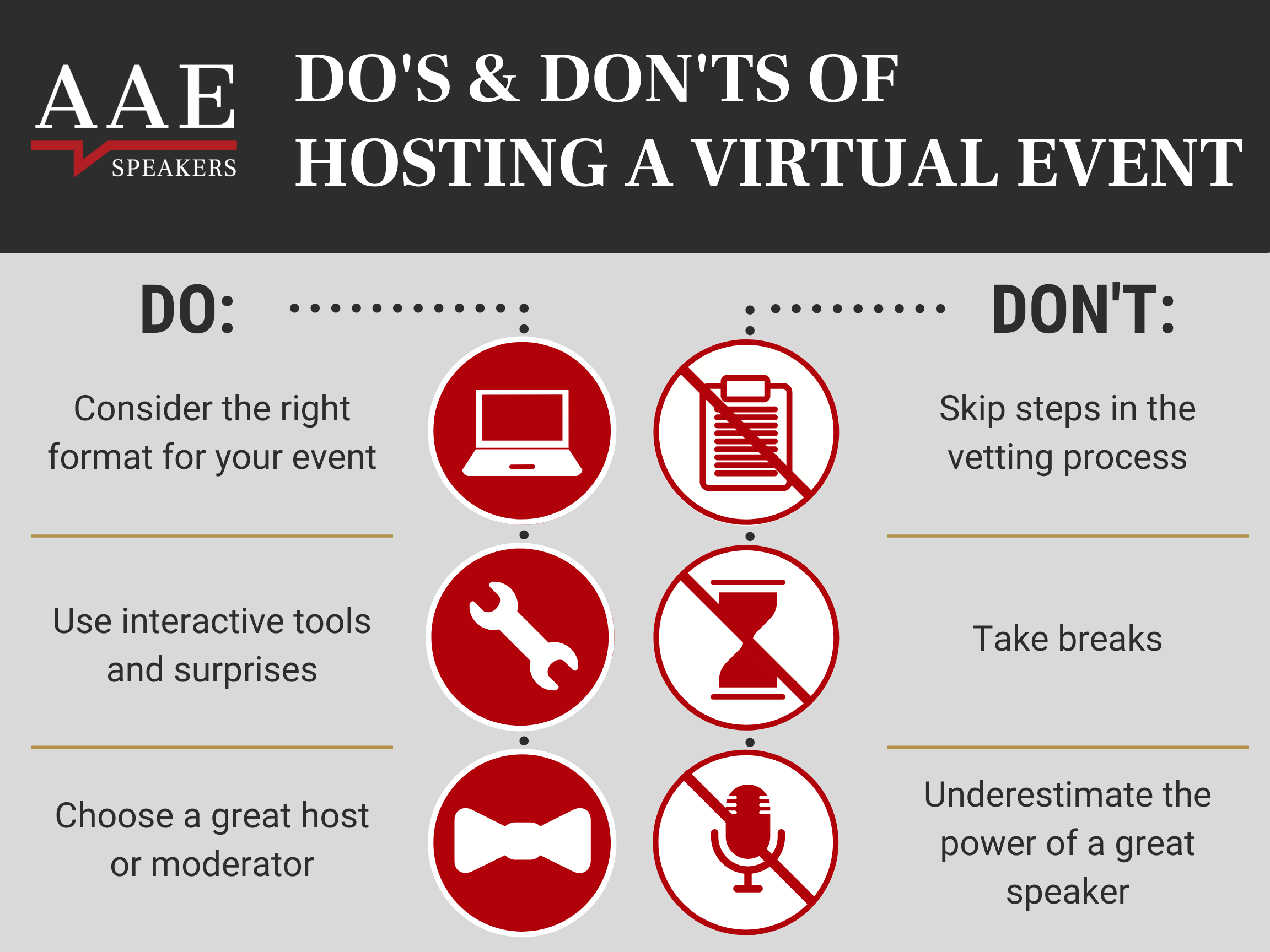As keynotes and conferences go virtual, the event industry is experiencing one of the greatest shifts in its history. This switch is an incredible opportunity for event planners and clients alike, and we believe that virtual events are here to stay. As your organization considers taking your event online, AAE is here to help. Here are our top six Do’s and Don’ts to consider when hosting a virtual event:
DO:
1. Consider the right format for your virtual event.
There are three main formats to choose from when planning your next virtual event. Each approach serves a different purpose and has its own set of pros and cons.
Option 1: Live. Live virtual events, or events that happen in real time, are one of the most common approaches to virtual events. When speakers present live, they create a “have to be there” scenario for attendees. Live events eliminate the option for your audience to tune in later, or worse, forget to watch the virtual event altogether. However, this is also why live virtual events can be risky. From time zone confusion to poor internet connection, there is more room for error when executing live events.
Option 2: Recorded. Pre-recorded events are another great option for your next virtual conference. Recorded events can provide your organization with a more polished final product, allowing you to redo portions of the sessions and clean up mistakes with video editing. The downside to recorded events, however, is the lack of urgency it creates for your audience. Recorded keynote speeches can seem less personal, and attendees can be less likely to engage with the content.
Option 3: Hybrid. According to All American Entertainment’s COO, Margo Dunnigan, “the hybrid event model takes the best of both worlds. It allows you to record presentations, but also air them live and perhaps have the speaker attend live, too.” The hybrid event format can offer a sense of security for your organization, ensuring that your speaker’s presentation runs smoothly before the event even starts. Afterwards, your hired talent can tune in for a live Q&A session without any post-performance nerves.
2. Engage your audience through interactive online tools and surprises.
Virtual events run the risk of feeling impersonal, but providing interactive tools and engaging content is the easiest way to combat screen fatigue and connect with your audience.
Most online event platforms include a variety of built-in interactive features like chat boxes, interactive polls, and more. Specifically, breakout rooms can be particularly effective in holding your audience’s attention and facilitating discussion. With a slight tweak to their keynote, your talent can pause their presentation, pose a question, and break viewers into small groups to interact with both the material and other attendees.
Another option to consider is hiring a surprise guest to make a virtual appearance. Dunnigan says, “there have been top name CEOs and celebrities that have made surprise appearances. It really gets a great buzz and excitement around your event. It creates a ‘have to be there’ kind of feel.” Whether attendees are surprised by a visit from a top celebrity or a farm animal, your virtual event is sure to be a hit.
3. Choose a great virtual event host or moderator.
It’s no surprise that securing a great speaker is one of the most important decisions in the planning process. But event planners often overlook another vital step for a successful virtual event: choosing the perfect host. A great moderator can elevate your virtual event in three ways.
First, moderators are the best way to ensure your virtual event flows together naturally. MCs can introduce your organization, interact with the talent, and bring energy to the event. Their role is to hold the audience’s attention during pauses and transitions, especially for multi-speaker virtual conferences. Second, moderators are the key to audience engagement. They can encourage attendee discussion in the chat box and implement the interactive tools mentioned above. Finally, great hosts can reduce the stress of your hired talent. Many top keynote speakers are still learning and transitioning to the virtual event space. Let your talent focus on their message, and leave the rest to the MC.
While moderators aren’t mandatory to ensure the success of your virtual event, they are strongly recommended. A trusted employee from your organization could make the perfect host. Looking to step up your virtual game? Connect with an agent at AAE to secure an MC today.

DON’T:
1. Skip steps in the vetting process.
In-person and virtual events can seem more different than they are similar. But in order to host a successful online conference, the vetting process should stay the exact same. All American Entertainment’s head of marketing, Jen Best, stresses just how important each step of the vetting process is when hosting a virtual event.
“Don’t skip any steps in the vetting process just because you’re shifting to an online virtual environment… Go through the practice sessions, the vetting process, the contract process. Everything else happens exactly the same way and you don’t want to bypass any of that to make sure that your event runs smoothly.”
Recording practice sessions and run-throughs is a good idea, especially if your virtual event will be broadcast in real-time. If technical difficulties or speaker emergencies arise, you’ll be prepared to continue your virtual event as planned and keep your audience engaged.
2. Take breaks.
Holding the attention span of your audience is never easy, but face-to-face conferences are much more forgiving. Most traditional events last an hour at minimum. Attendees can interact with each other more easily, listen to the speaker with fewer distractions, and actively engage with the physical environment around them.
When hosting a virtual event, however, it is much harder to maintain your audience’s attention. It’s easy to passively attend online sessions, and attendees are constantly tempted with distractions in their homes and on their devices. Including breaks between speakers, sessions, and transitions is often the perfect excuse for attendees to check out. And once you lose your audience, they aren’t likely to return.
If taking a break is necessary for your event, we recommend calling on your moderator to keep the conversation flowing among attendees. By introducing your organization, reminding the audience to engage with others in the chat box, or publicizing your next event, attendees will be much more likely to stick around. The best option, however, is keeping your content flowing and removing any breaks from your virtual event altogether.
3. Underestimate the power of hiring a great speaker.
While the industry-wide shift to virtual events might seem unfavorable, it’s the perfect opportunity for your organization to secure previously unattainable talent. During these unprecedented times, in-person events are postponed, speaker schedules are rearranged, and even the biggest names in the speaking industry are looking for virtual keynote opportunities. Plus, some speaker fees have decreased significantly over the past months for online events.
Best stresses the potential impact of hiring a top speaker. “This goes beyond your event. This goes into registration for your event in advance, carrying through to the excitement about attending your event, to the power of a top name speaker or celebrity at your event.” If you want to increase attendance and hype for your next keynote, consider hosting a relevant celebrity or speaker virtually. Take a look at our list of top virtual speakers to book.




